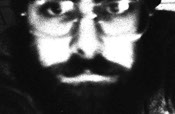Jacques Legare, Belgian-American Photographer (c. 1938–1989)

Is this Jacques Legare?
It is unfortunate that no confirmed photos of Legare himself can be found, but this frame was found on a strip of negatives that seems to be test shots. In testing the shutter or lens of the camera, Legare may have turned the camera around and captured himself in the photo. He appears here to be between 30 and 40 years old, which places the photo around 1967-1970.
Legare's life is not well documented
Jacques Legare was born in Antwerp, Belgium, in either 1937 or 1938, just before World War II. Because Antwerp's City Hall was destroyed in an Allied bombing raid in 1943, it is impossible to know for sure.
We do know that he attended the Académie Royale des Beaux-Arts in Brussels from 1956–1961, where he studied lithography and painting, graduating with honors. For a short time he worked in the studio of renowned Belgian painter and printmaker Éliane de Meuse (1899-1993), and is thought to have been a factor in the breakup of her marriage to painter Max Constant Armand Van Dyck (1902-1992) in 1964, even though de Meuse was nearly 40 years Legare's senior. It is thought that this affair led to Legare's leaving Brussels in about 1965. He quit Belgium, never to return alive.
There is no record of Legare's whereabouts for the more than two years after his departure from Brussels until he resurfaced in early 1967 in Lima, Peru, where he first exhibits his work as a photographer. The influential Pelicula Moreno gallery, epicenter of Peru's nascent art scene, virtually adopted Legare as a mascot during the turbulent but brief years of La Revista Peru, as the period was known. It is here that Legare first begins to consider that his future as an artist might lie in the realm of the captured image, not the painted one.
But Legare tired of Peru after the breakup of a romance with Señora Moreno, the ebullient owner of Pelicula Moreno. In late 1968, Legare made his way to New York, and effectively vanished.
We do know that Legare lived for a short time on Manhattan's then gritty Lower East Side. English, for the most part, eluded Legare, and he probably found comfort in a neighborhood of mostly Spanish speakers. It is here he is thought to have met artists and musicians of the Nuyorican movement, as well as Swiss-born photographer Robert Frank, who had a well-known weakness for spirited Peruvian women.
Frank would have a major influence on Legare's work in the years that followed, including his helping to arrange a groundbreaking show of Legare's work at the Leica Gallery in Manhattan in 1969, and in a small group show with several Warhol Factory artists the next year. But beyond those exhibits, and brief mentions in Frank's letters, Legare is not heard from again until a small notice about his death appeared in The Daily News nearly twenty years later.
What happened? Where did Legare go? Until the discovery of these negatives in a Paterson storage unit, these were unanswered questions. It's my hope that by publishing Legare's images, even in this modest way, I can help answer these questions, and bring the work of a largely unknown artist to the world for the appreciation it so richly deserves.
If you have any questions about the works presented, or how they were found, please contact me..
References:
© 2016 Jacques Legare Photographic Trust, LLC